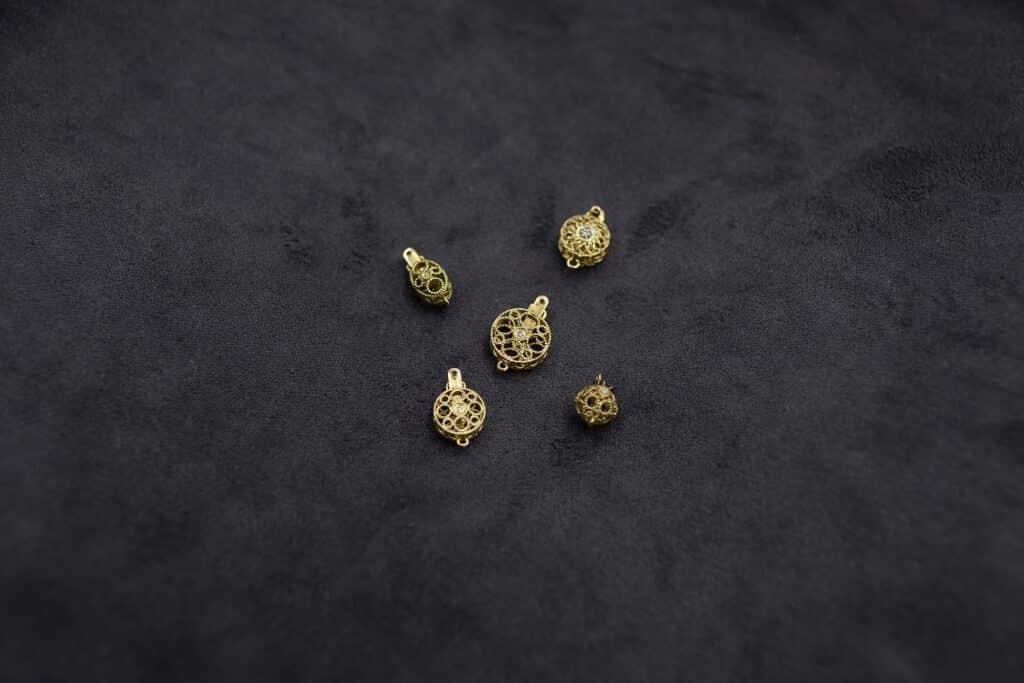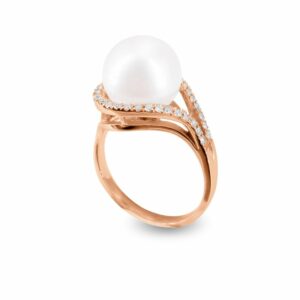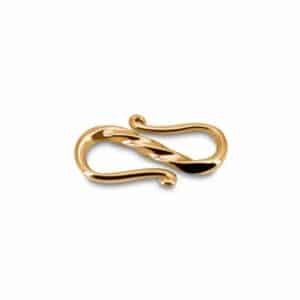Clasp Findings in Jewelry Making: An Overview
Clasp findings are functional components used in the creation and repair of various types of jewelry, such as necklaces, bracelets, and anklets. They serve as a secure and convenient way to fasten and unfasten jewelry pieces, ensuring that they stay in place while being worn. Clasps can be made from a variety of materials, including metals like gold, silver, and brass, as well as glass, plastic, and natural materials like shells and stones. They come in numerous styles and designs to suit different types of jewelry and wearer preferences.
Clasp findings play a crucial role in jewelry making, as they provide both functionality and aesthetic value to the finished piece. A well-designed clasp not only secures the jewelry piece comfortably and reliably but can also enhance the overall appearance and style of the piece.
Styles of Clasp Findings
Clasp findings are essential components of various types of jewelry, including necklaces, bracelets, and anklets. They help secure the jewelry pieces in place and ensure that they do not fall off during wear. There are numerous styles of clasps available in the market, each with its unique features, advantages, and disadvantages. This section will explore three main categories of clasp findings: traditional clasps, modern clasps, and unique clasps.
Traditional Clasps
Traditional clasps are classic designs that have been used for centuries in jewelry making. They are often simple and easy to use, offering a secure connection for the wearer. These clasps are usually made of metal, such as gold, silver, or brass, and can be found in various sizes and styles to accommodate different types of jewelry.
Spring Ring Clasp
Advantages:
- The spring ring clasp is simple and easy to use, making it an excellent choice for those who prefer a straightforward and functional clasp.
- Its lightweight design makes it ideal for delicate jewelry pieces, such as thin necklaces and bracelets.
- When compared to other types of clasps, the spring ring clasp is relatively inexpensive, making it an affordable option for various jewelry designs.
Disadvantages:
- For individuals with dexterity issues, such as arthritis, the small size and spring mechanism of the spring ring clasp can be challenging to manipulate.
- The spring ring clasp may not provide enough support for heavier or bulkier jewelry pieces, as its strength is limited by the size and materials used.
Lobster Clasp
Advantages:
- The lobster clasp is more secure than a spring ring clasp due to its design and larger size, making it less likely to accidentally open.
- It can accommodate heavier and bulkier jewelry pieces, providing more support and strength compared to a spring ring clasp.
- The lobster clasp is available in a variety of sizes and styles, allowing it to be used in various jewelry designs.
Disadvantages:
- Due to its larger size and mechanism, the lobster clasp can be more difficult to operate for those with dexterity issues.
- Lobster clasps are typically more expensive than spring ring clasps, making them a costlier option for jewelry designs.
Modern Clasps
Modern clasps are innovative designs that incorporate new materials, technologies, and mechanisms to provide improved functionality and aesthetics. These clasps often prioritize ease of use, security, and versatility, making them a popular choice for contemporary jewelry designs. Modern clasps can be made from various materials, such as metal, glass, and plastic, and can be found in a wide range of styles to suit different jewelry pieces.
Magnetic Clasp
Advantages:
- The magnetic clasp is easy to use, making it a suitable choice for individuals with dexterity issues.
- It provides a secure connection due to the magnetic attraction, which ensures that the jewelry piece stays in place.
- The magnetic clasp is available in various shapes, sizes, and styles, offering a range of options for different jewelry designs.
Disadvantages:
- Over time, the magnetic strength may weaken, potentially compromising the clasp’s security.
- Magnetic clasps are not recommended for individuals with pacemakers or other medical devices affected by magnets, as they can interfere with the proper functioning of these devices.
Toggle Clasp
Advantages:
- The toggle clasp is easy to fasten and unfasten with one hand, making it convenient for users.
- It can act as a decorative element in the jewelry design, adding visual interest to the piece.
- The toggle clasp is suitable for a variety of jewelry styles, including bracelets and necklaces.
Disadvantages:
- Toggle clasps may not be as secure as other types of clasps, as the bar can slip out of the loop if it is not properly sized or if the jewelry piece is pulled.
- The toggle clasp can be bulky, making it unsuitable for delicate jewelry designs that require a more subtle and streamlined clasp.
Unique Clasps
Unique clasps are creative and unconventional designs that offer an artistic touch to jewelry pieces. These clasps are often used as focal points or statement pieces, adding a distinctive and eye-catching element to the jewelry design. Unique clasps can be made from a variety of materials, including metal, glass, and natural materials such as shells and stones.
Hook and Eye Clasp
Advantages:
- The hook and eye clasp is easy to use, making it suitable for those with dexterity issues.
- It can serve as a decorative element in the jewelry design, adding an artistic touch to the piece.
- The hook and eye clasp works well with lightweight and delicate jewelry pieces, providing adequate support without adding unnecessary bulk.
Disadvantages:
- The hook and eye clasp may not provide enough security for heavier or bulkier jewelry pieces, as the hook can slip out of the eye if it is not properly sized or if the jewelry piece is pulled.
- The clasp can become unfastened if it gets caught on clothing or other objects, potentially causing the jewelry piece to fall off.
S-Hook Clasp
Advantages:
- The S-hook clasp offers a unique and artistic design, making it an attractive option for those who want a statement clasp in their jewelry.
- The S-hook clasp can be used as a decorative element in the jewelry design, adding a distinctive touch to the piece.
- This clasp is suitable for various jewelry styles, such as necklaces, bracelets, and anklets, due to its versatile design.
Disadvantages:
- The S-hook clasp may not be as secure as other types of clasps, as the hook can slip out of the loop or attachment point if it is not properly sized or if the jewelry piece is pulled.
- For those with dexterity issues, fastening and unfastening the S-hook clasp can be challenging.
Slide Lock Clasp
Advantages:
- The slide lock clasp provides a secure connection for multi-strand jewelry designs, ensuring that all strands are held together and aligned.
- It offers a sleek and streamlined appearance, making it an attractive choice for contemporary jewelry designs.
- The slide lock clasp is easy to use and fasten, providing convenience for the wearer.
Disadvantages:
- The slide lock clasp may not be suitable for single-strand jewelry designs, as it is specifically designed to accommodate multiple strands.
- It can be more expensive than other types of clasps, making it a higher-cost option for jewelry designs.
- The slide lock clasp has limited availability in various styles and sizes, which may restrict its use in certain jewelry designs.
Box Clasp
Advantages:
- The box clasp offers a secure connection due to its locking mechanism, ensuring that the jewelry piece stays in place.
- It can be used as a decorative element in the jewelry design, adding elegance and sophistication to the piece.
- The box clasp is suitable for various types of jewelry, including bracelets and necklaces, due to its versatile design and secure connection.
Disadvantages:
- For those with dexterity issues, fastening and unfastening the box clasp can be challenging due to the small locking mechanism.
- Box clasps are typically more expensive than other types of clasps, making them a costlier option for jewelry designs.
There are many different types of clasp findings available, each with their own set of advantages and disadvantages. When choosing a clasp for a jewelry design, consider factors such as ease of use, security, aesthetics, and the specific requirements of the jewelry piece. By understanding the benefits and drawbacks of each clasp style, you can select the most appropriate option for your jewelry design, ensuring both functionality and visual appeal.
Combining Clasp Findings with Jewelry
Matching the Material of the Clasp to the Jewelry
Ensuring that the clasp material complements the materials used in the jewelry piece contributes to a cohesive and harmonious appearance. This approach not only enhances the visual appeal of the design but also supports the overall durability of the piece, as matching materials often share similar properties and wear patterns.
Examples of matching materials:
- For a sterling silver necklace, choose a sterling silver clasp to maintain a cohesive appearance.
- If the jewelry piece features gold-filled beads or accents, opt for a gold-filled clasp to complement the design.
- In the case of a leather bracelet, consider using a metal clasp that matches the metal accents used throughout the piece, such as brass or copper.
Matching the Size of the Clasp to the Jewelry
Selecting the appropriate clasp size for a jewelry piece is crucial for ensuring a secure and comfortable fit while maintaining aesthetic balance. A well-matched clasp size enhances the overall design without overpowering or detracting from the jewelry piece, providing both functionality and visual appeal.
Examples of matching sizes:
- For a delicate, thin chain necklace, select a small, lightweight clasp, such as a spring ring clasp, to avoid overwhelming the design.
- In contrast, a heavy or bulky jewelry piece, like a thick chain bracelet, requires a larger and more robust clasp, such as a lobster clasp or a large toggle clasp, to provide sufficient support.
Matching the Style of the Clasp to the Jewelry
Choosing a clasp style that complements the overall style of the jewelry piece creates a unified and visually pleasing design. By considering the aesthetic theme of the piece, jewelry makers can select a clasp that enhances the design while providing the necessary functionality and security for the wearer.
Examples of matching styles:
- For a minimalist, contemporary jewelry piece, choose a sleek and modern clasp, such as a magnetic or slide lock clasp.
- If the jewelry design features a vintage or antique aesthetic, opt for a traditional clasp, like a box clasp, to maintain the overall style.
- In the case of a bohemian or eclectic jewelry design, a unique clasp, like an S-hook or hook and eye clasp, can serve as a complementary focal point.
Using Multiple Clasp Findings in One Piece of Jewelry
Dual Clasps
Incorporating dual clasps in a jewelry piece can offer increased versatility and adaptability in the design. This approach allows wearers to explore various configurations, styles, or the addition of charms and pendants, providing a customizable and dynamic jewelry-wearing experience.
Examples of dual clasps:
- A long necklace can feature two lobster clasps at each end, allowing the wearer to wrap the necklace around their neck multiple times and secure it in various configurations.
- A bracelet with two spring ring clasps can be used to connect a detachable charm or pendant, providing versatility in the jewelry design.
Multi-Strand Bracelets and Necklaces
Multi-strand jewelry designs benefit from the use of clasps that can effectively secure multiple strands at once while maintaining alignment and aesthetic cohesion. By selecting the appropriate clasp for multi-strand designs, jewelry makers can create visually pleasing and functional pieces that cater to various tastes and preferences.
Examples of multi-strand jewelry:
- A multi-strand necklace can utilize a slide lock clasp, which secures multiple strands at once and ensures that they remain aligned.
- A multi-strand bracelet with a single toggle clasp can keep all the strands together while maintaining a cohesive and stylish appearance.
Layering Different Types of Clasp Findings
Combining various clasp types in a single jewelry piece can create a unique and dynamic design that showcases the wearer’s personal style and creativity. This approach encourages experimentation with different clasp styles, materials, and sizes, resulting in one-of-a-kind jewelry pieces that express individuality and flair.
Examples of layered clasps:
- A layered necklace design can incorporate various types of clasps for each strand, such as a spring ring clasp for a thin chain and a lobster clasp for a more substantial chain, adding visual interest and variety to the piece.
- A multi-layered bracelet can feature a combination of different clasps, like a magnetic clasp for one strand and a hook and eye clasp for another, creating a unique and dynamic design.
By understanding the various factors that influence the choice of clasp for a particular jewelry design, such as material, size, and style, and considering the potential for incorporating multiple clasps in a single piece, jewelry makers can create beautiful, functional, and harmonious pieces that cater to diverse preferences and styles.
Takeaways on Clasps Findings
Throughout this article, we have explored various clasp finding styles, including traditional clasps, modern clasps, and unique clasps. Each style offers distinct advantages and disadvantages, catering to different jewelry designs, preferences, and wearer needs.
Selecting the right clasp for your jewelry is essential to ensure the piece is comfortable to wear, easy to put on and take off, and securely fastened during wear.
By considering factors such as material, size, and style, and understanding the various clasp types available, you can make informed decisions when choosing the most suitable clasp for your jewelry designs, resulting in beautiful and functional pieces that stand the test of time.
Frequently Asked Questions about Clasp Findings
- Q: Can I replace a clasp on my existing jewelry piece?
A: Yes, you can replace a clasp if it’s damaged or if you prefer a different style. It’s best to consult with a professional jeweler to ensure the replacement is done correctly and securely. - Q: Can a clasp affect the overall value of a piece of jewelry?
A: Yes, the type and quality of a clasp can impact the value of a jewelry piece. High-quality clasps made from precious metals like gold or platinum can add value, while a poorly made or damaged clasp can detract from the piece’s overall worth. It’s essential to choose a clasp that complements the design and quality of your jewelry. - Q: How can I determine the quality of a clasp when purchasing jewelry?
A: When purchasing jewelry, closely examine the clasp to ensure it’s well-made and secure. Look for signs of quality, such as smooth edges, a sturdy design, and a secure closure mechanism. Additionally, ask the jeweler about the materials used for the clasp and any warranties or guarantees they offer. High-quality clasps are an essential aspect of a durable and valuable jewelry piece.



